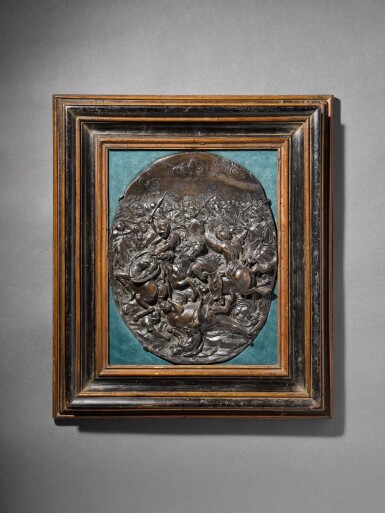
After Daniel Neuberger
Relief with a Battle Scene
Auction Closed
June 10, 02:51 PM GMT
Estimate
6,000 - 8,000 GBP
Lot Details
Description
After Daniel Neuberger (Augsburg 1621–1680)
Southern German or Austrian, second half 17th century
Relief with a Battle Scene
inscribed: D. NEVBERGER / INV. Ao 1653
bronze, in a partially ebonised wood frame
bronze: 31.5 by 25.5cm., 12⅜ by 10in.
frame: 48 by 41.5cm., 18⅞ by 16⅜in.
With Daniel Katz, 1960s;
D. H. Thomas Trust, until 2013
Oxford, Ashmolean Museum, 1990 - 2013 (on loan)
Recently the subject of renewed scholarly interest, the ingenious wax sculptor Daniel Neuberger was recorded in the Teutsche Academie, Joachim von Sandrart’s famous observations on the most celebrated artists of mid-17th century Germany. Born in 1621 into an Augsburg family of artists, he was called to the Imperial Court in Vienna by Ferdinand III, where he remained until 1663. Specialising in virtuoso wax sculpture, which often imitated other materials, he enjoyed a prosperous career, later settling in Regensburg.
Neuberger was celebrated for his intricate classical battle scenes derived from engravings by Antonio Tempesta, of which a prime example (in wax) is housed in the Kunsthistorisches Museum, Vienna (inv. no. KK 3079). The present bronze relief depicting an ancient Roman battle relates closely in style to Neuberger’s wax relief and, given its inscription of ‘Daniel Neuberger invenit’, is likely to be based on a wax model by the sculptor. While no bronzes by Neuberger are recorded and it is unclear to what extent he may have produced models to be cast in metal, it was proposed by Klapsia (op. cit.) that Neuberger’s workshop may have had a ‘reproduction arm’ in which models in wax and plaster intended for casting were created after the master’s originals.
RELATED LITERATURE
H. Klapsia, ‘Beiträge zur Kunsttätigkeit am österreichischen Kaiserhofe im 17. Jahrhundert, III: Daniel Neuberger’, in Jahrbuch der Kunsthistorischen Sammlungen in Wien, vol. IX, 1935; J. Diehl et al., Wachs in seinen Händen: Daniel Neubergers Kunst der Täuschung, exh. cat. Kunsthistorisches Museum, Vienna, 2025
You May Also Like










